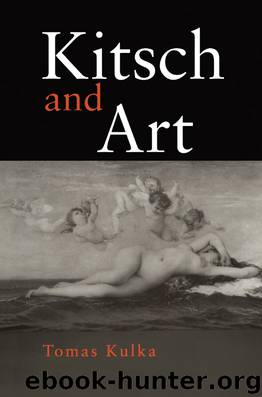Kitsch and Art by Thomas Kulka

Author:Thomas Kulka
Language: eng
Format: epub
Publisher: Penn State University Press
This brings us back to the deceptive nature of kitsch, which earlier we were unable to explain. At the beginning of this chapter we quoted a remark of Matei Calinescu, who noted that “[kjitsch may be conveniently defined as a specifically aesthetic form of lying” (Faces of Modernity 229). We can now understand what kind of deception is involved here. Kitsch plays a rather subtle little trick on its consumers. They may believe that they like (and aesthetically appreciate) the symbol—that is, the kitsch picture—for its specific aesthetic properties, while what they are really affected by is the emotional charge of its referent, which may have nothing to do with its specific features. Consumers of kitsch look through the symbol, so to speak, to what the symbol stands for. The dominance of the referential function, on which the effect of kitsch is entirely dependent, carries its consumers straight from the picture (which they seldom scrutinize) to what the picture stands for. We can thus see that the appeal of kitsch is totally parasitic on the associations related to its referent. In kitsch paintings, unlike in real art, what is represented is more important than how it is rendered. The what overshadows the how.
We have noted above that kitsch has all the properties of paintings, that it indeed looks like any other painting; it just does not function the same way. This raises the question of whether the aesthetic worthlessness of kitsch is an intrinsic or immanent property. If it is a function that underlies the status of kitsch rather than its intrinsic properties, couldn’t it be that other pictures not normally considered kitsch could also function as transparent symbols (that is, as kitsch)? Couldn’t a person admire Titian’s Venus, Tintoretto’s Sussana and the Elders, or Modigliani’s Reclining Nude not for the aesthetic properties of the rendering, but, just as in the case of kitsch, simply for what these pictures represent? Couldn’t one appreciate such paintings simply as beautiful-woman-representing pictures in much the same manner as one may appreciate the pictures in the Playboy magazine? If so, couldn’t Titian, Tintoretto, and Modigliani also function as kitsch?
It is this kind of context, I believe, that prompted Hermann Broch and Ludwig Giesz to introduce the notion of the Kitschmensch, or kitsch-man, referring to the “man of bad taste,” or rather to “the way in which a person of bad taste looks at, enjoys and acts when confronted with a work of art (either good or bad)” (in Dorfles, ed., Kitsch 15). Indeed, any work of art can be looked at transparently so that the specific features of its rendering and its aesthetic properties are ignored.43 The standard associations related to the subject matter of the depiction may be equally well triggered by kitsch and by a great work of art. The point is that, in contrast to real art, this is all that we can ever get from kitsch. Given frequent exposure and perhaps some instruction, our “kitsch-man” may come to appreciate the nontransparent qualities of artistic paintings.
Download
This site does not store any files on its server. We only index and link to content provided by other sites. Please contact the content providers to delete copyright contents if any and email us, we'll remove relevant links or contents immediately.
Call Me by Your Name by André Aciman(20371)
Ready Player One by Cline Ernest(14524)
How to Be a Bawse: A Guide to Conquering Life by Lilly Singh(7391)
Wiseguy by Nicholas Pileggi(5671)
The Kite Runner by Khaled Hosseini(5083)
On Writing A Memoir of the Craft by Stephen King(4863)
Audition by Ryu Murakami(4850)
The Crown by Robert Lacey(4723)
Call me by your name by Andre Aciman(4619)
Gerald's Game by Stephen King(4581)
Harry Potter and the Cursed Child: The Journey by Harry Potter Theatrical Productions(4440)
Dialogue by Robert McKee(4321)
The Perils of Being Moderately Famous by Soha Ali Khan(4169)
Dynamic Alignment Through Imagery by Eric Franklin(4116)
Apollo 8 by Jeffrey Kluger(3637)
Seriously... I'm Kidding by Ellen DeGeneres(3577)
The Inner Game of Tennis by W. Timothy Gallwey(3575)
How to be Champion: My Autobiography by Sarah Millican(3555)
Darker by E L James(3477)
